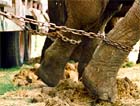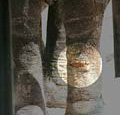| Ringling
Brothers says this "Trainers teach animals routines that showcase their
natural behaviors, beauty, and distinctive personalities."
In nature elephants do not just stand on their heads, bears can't jump on a trampoline, and tigers don't walk around on two legs. Getting them to do these confusing tasks is extremely difficult and requires much training. They often use whips, muzzles, electric prods, and bull hooks to get the animals to do what they please. Between acts animals are kept in cages or chained. When they are kept in cages there is often barely enough room for them to take one step. When they are chained the chains are sometimes so tight that they will cut, bruise, or cut off the animals circulation.
|
||
| The animals are also sometimes mutated to create a twisted 'sideshow'. Ringling Brothers has mutated a baby goats head by removing both horns, then surgically attaching one to the middle of its head. Creating a sick looking unicorn. Is this what we are paying money for? To see animals hurt, killed, and literally tortured for our own entertainment. I thought mankind was much more sophisticated than that. I thought we were past the era where Gladiators killed each other and dogs fought to the death, so we wouldn't be bored. |




